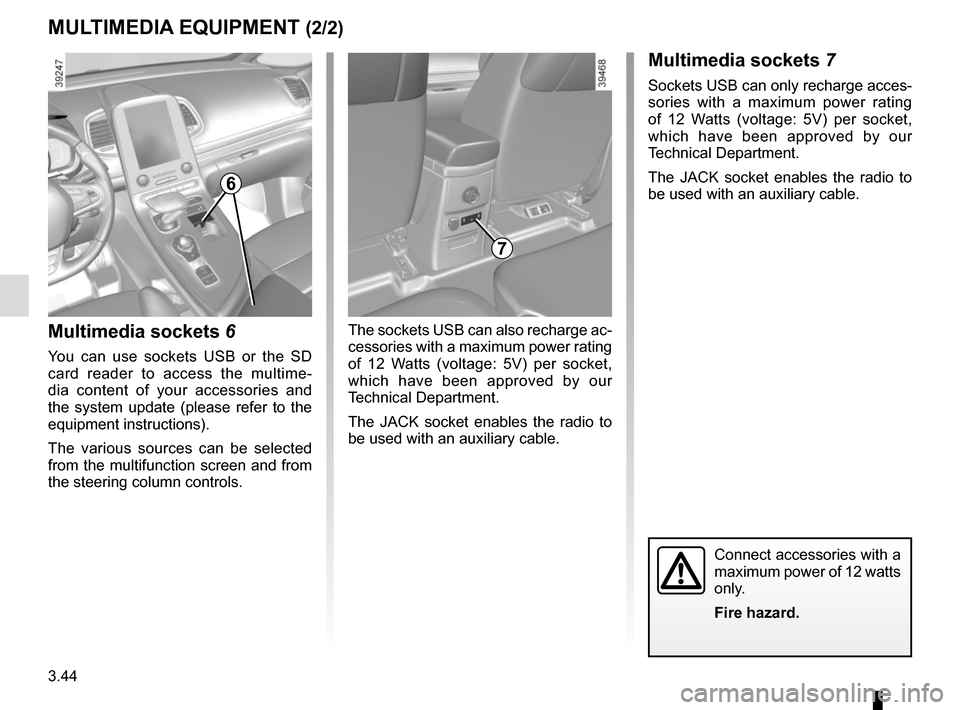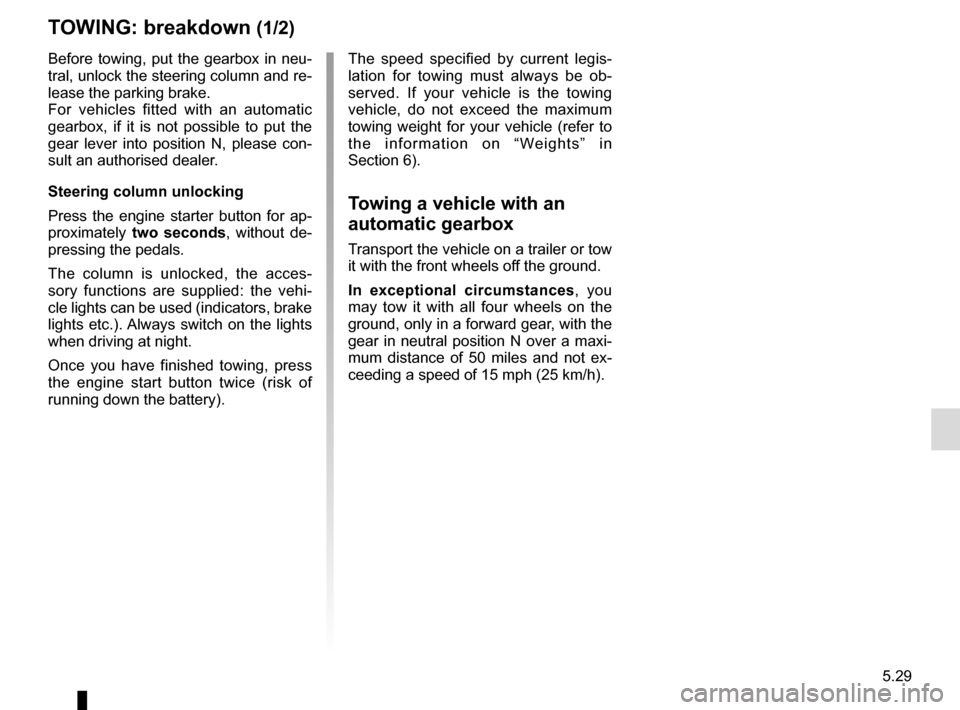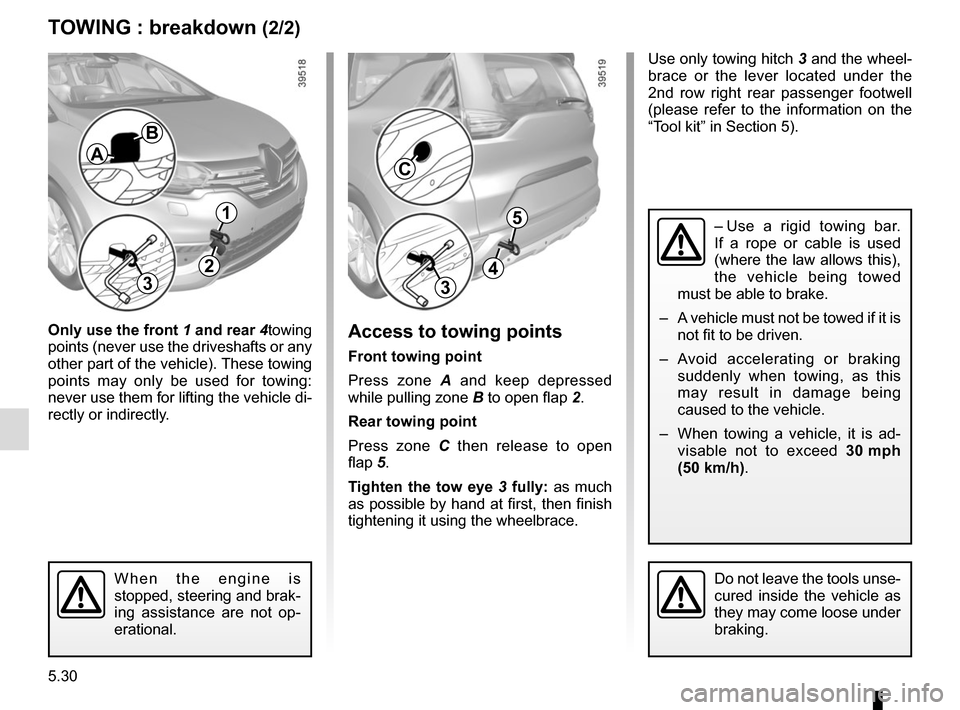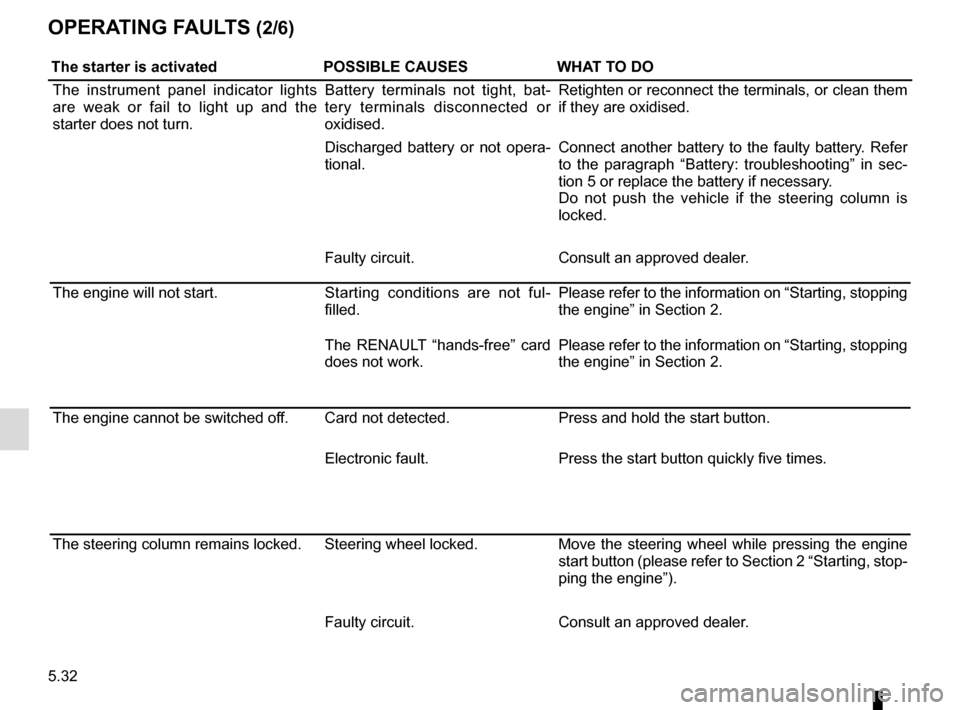2015 RENAULT ESPACE steering
[x] Cancel search: steeringPage 235 of 316

3.43
MULTIMEDIA EQUIPMENT (1/2)
Using the telephone
We remind you of the need
to conform to the legislation
in force concerning the use
of such equipment.
5
Hands-free telephone
integrated control
For equipped vehicles, use the steering
wheel controls 4.
Multimedia systems
1 Multimedia touchscreen display;
2 Central control;
3 Steering column controls;
4 Steering wheel controls;
5 Microphone.
1
2
4
Refer to the equipment instructions
for information on how to operate
this equipment.
3
Page 236 of 316

3.44
Multimedia sockets 6
You can use sockets USB or the SD
card reader to access the multime-
dia content of your accessories and
the system update (please refer to the
equipment instructions).
The various sources can be selected
from the multifunction screen and from
the steering column controls.
7
MULTIMEDIA EQUIPMENT (2/2)Multimedia sockets 7
Sockets USB can only recharge acces-
sories with a maximum power rating
of 12 Watts (voltage: 5V) per socket,
which have been approved by our
Technical Department.
The JACK socket enables the radio to
be used with an auxiliary cable.
The sockets USB can also recharge ac-
cessories with a maximum power rating
of 12 Watts (voltage: 5V) per socket,
which have been approved by our
Technical Department.
The JACK socket enables the radio to
be used with an auxiliary cable.
Connect accessories with a
maximum power of 12 watts
only.
Fire hazard.
6
Page 268 of 316

5.14
TYRES (3/3)
For safety reasons, this op-
eration must be carried out
by a specialist.
Fitting different tyres may
change your vehicle as follows:
– it may mean that your vehicle no longer conforms to current regu-
lations;
– it may change the way it handles when cornering;
– it may cause the steering to be heavy;
– It may affect the use of snow chains.
Use in winter
Chains
For safety reasons, fitting snow
chains to the rear axle is strictly for-
bidden.
Chains cannot be fitted to tyres which
are larger than those originally fitted to
the vehicle.
Snow or Winter tyres
We would recommend that these be
fitted to all four wheels to ensure that
your vehicle retains maximum adhe-
sion.
Warning : These tyres sometimes have
a specific direction of rotation and a
maximum speed index which may be
lower than the maximum speed of your
vehicle.
Snow chains may only be
fitted to tyres of the same
size as those originally
fitted to your vehicle.
In all cases, we would recommend
that you contact an authorised
dealer who will be able to advise you
on the choice of equipment which is
most suitable for your vehicle.
Changing a wheel
As the tyre pressure moni-
tor may take several min-
utes to correctly determine
the positions of the wheels and the
pressure values after driving, check
the tyre pressures following any op-
eration.
Studded tyres
This type of equipment may only be
used for a limited period and as laid
down by local legislation. It is neces-
sary to observe the speed specified by
current legislation.
These tyres must, at a minimum, be
fitted to the two front wheels.
19” wheels and larger
cannot be fitted with
chains.
If you wish to use special
equipment, please consult an au-
thorised dealer.
Fitting new tyres
Page 283 of 316

5.29
TOWING: breakdown (1/2)
Before towing, put the gearbox in neu-
tral, unlock the steering column and re-
lease the parking brake.
For vehicles fitted with an automatic
gearbox, if it is not possible to put the
gear lever into position N, please con-
sult an authorised dealer.
Steering column unlocking
Press the engine starter button for ap-
proximately two seconds , without de-
pressing the pedals.
The column is unlocked, the acces-
sory functions are supplied: the vehi-
cle lights can be used (indicators, brake
lights etc.). Always switch on the lights
when driving at night.
Once you have finished towing, press
the engine start button twice (risk of
running down the battery). The speed specified by current legis-
lation for towing must always be ob-
served. If your vehicle is the towing
vehicle, do not exceed the maximum
towing weight for your vehicle (refer to
the information on “Weights” in
Section 6).
Towing a vehicle with an
automatic gearbox
Transport the vehicle on a trailer or tow
it with the front wheels off the ground.
In exceptional circumstances
, you
may tow it with all four wheels on the
ground, only in a forward gear, with the
gear in neutral position N over a maxi-
mum distance of 50 miles and not ex-
ceeding a speed of 15 mph (25 km/h).
Page 284 of 316

5.30
TOWING : breakdown (2/2)
Only use the front 1 and rear 4towing
points (never use the driveshafts or any
other part of the vehicle). These towing
points may only be used for towing:
never use them for lifting the vehicle di-
rectly or indirectly.Access to towing points
Front towing point
Press zone A and keep depressed
while pulling zone B to open flap 2.
Rear towing point
Press zone C then release to open
flap 5.
Tighten the tow eye 3 fully: as much
as possible by hand at first, then finish
tightening it using the wheelbrace.
When the engine is
stopped, steering and brak-
ing assistance are not op-
erational.Do not leave the tools unse-
cured inside the vehicle as
they may come loose under
braking.
4
5
3
C
Use only towing hitch 3 and the wheel-
brace or the lever located under the
2nd row right rear passenger footwell
(please refer to the information on the
“Tool kit” in Section 5).
– Use a rigid towing bar.
If a rope or cable is used
(where the law allows this),
the vehicle being towed
must be able to brake.
– A vehicle must not be towed if it is not fit to be driven.
– Avoid accelerating or braking suddenly when towing, as this
may result in damage being
caused to the vehicle.
– When towing a vehicle, it is ad- visable not to exceed 30 mph
(50 km/h).
2
B
A
1
3
Page 286 of 316

5.32
OPERATING FAULTS (2/6)
The starter is activatedPOSSIBLE CAUSESWHAT TO DO
The instrument panel indicator lights
are weak or fail to light up and the
starter does not turn. Battery terminals not tight, bat-
tery terminals disconnected or
oxidised.Retighten or reconnect the terminals, or clean them
if they are oxidised.
Discharged battery or not opera-
tional. Connect another battery to the faulty battery. Refer
to the paragraph “Battery: troubleshooting” in sec-
tion 5 or replace the battery if necessary.
Do not push the vehicle if the steering column is
locked.
Faulty circuit. Consult an approved dealer.
The engine will not start. Starting conditions are not ful-
filled.Please refer to the information on “Starting, stopping
the engine” in Section 2.
The RENAULT “hands-free” card
does not work. Please refer to the information on “Starting, stopping
the engine” in Section 2.
The engine cannot be switched off. Card not detected. Press and hold the start button.
Electronic fault. Press the start button quickly five times.
The steering column remains locked. Steering wheel locked. Move the steering wheel while pressing the engine
start button (please refer to Section 2 “Starting, stop-
ping the engine”).
Faulty circuit. Consult an approved dealer.
Page 288 of 316

5.34
OPERATING FAULTS (4/6)
On the roadPOSSIBLE CAUSESWHAT TO DO
Steering becomes heavy. Assistance overheating. Consult an approved dealer.
The engine is overheating. The cool-
ant temperature indicator is in the
warning zone and warning light
® comes on. Engine cooling fan not working. Stop the vehicle, switch off the engine and
contact an approved dealer.
Coolant leaks. Check the coolant reservoir: it should con- tain fluid. If there is no coolant, consult an
authorised dealer as soon as possible.
Coolant boiling in the coolant reser-
voir. Mechanical fault: damaged cylinder
head gasket. Stop the engine.
Contact an approved dealer.
Radiator:
If there is a significant lack of coolant, remember that it must never b\
e topped up using cold coolant while
the engine is very warm. After any procedure on the vehicle which has involved even partial drain\
ing of the cooling
system, it must be refilled with a new mixture prepared in the correct p\
roportions. Reminder: only products approved
by our Technical Department may be used for this purpose.
Page 312 of 316

7.4
ALPHABETICAL INDEX (4/5)
Multi-Sense.............................................................\
.... 3.2 – 3.3
N
navigation ............................................................... 3.43 – 3.44
navigation system ................................................... 3.43 – 3.44
O
oil change ..................................................................... 4.4, 4.6
opening the doors ....................................................1.8 → 1.13
operating faults ......................................................5.31 → 5.36
overspeed warning .......................................1.70, 2.49 → 2.51
P
paintwork maintenance ..................................................... 4.14 – 4.15
parking assistance: assisted parking 2.63 → 2.66, 2.69 → 2.72
parking distance control.........................................2.63 → 2.66
power-assisted steering.................................................\
.... 1.86
powered tailgate ....................................................1.15 → 1.19
puncture................................................. 5.2 → 5.4, 5.8 → 5.11
R
radio...................................................................\
..... 3.43 – 3.44
rear drive wheels ..........................................2.26 → 2.37, 2.37
rear parcel shelf ........................................................ 3.27, 3.36
rear screen de-icing/demisting .......................................... 3.11
rear seats functions ..........................................................3.30\
→ 3.34
rear view camera .................................................... 2.67 – 2.68
rear view mirrors ....................................................1.87 → 1.89
RENAULT ANTI-INTRUDER DEVICE (RAID) ................... 1.14
RENAULT card battery ................................................................\
.......... 5.25
use ....................................................................\
...1.2 → 1.7
RENAULT card battery ...................................................... 5.25
replacement parts ................................................................ 6.7 reverse gear
selecting ..................................................2.12, 2.74 → 2.79
reversing sensor ....................................................2.63 → 2.66
roof bars ........................................................................\
.... 3.42
roof rack roof bars ....................................................................... 3.42
running in ........................................................................\
..... 2.2
S
safety distance warning .......................................... 2.44 – 2.45
safety distances ...................................................... 2.44 – 2.45
screen fold-away screen .......................................................... 1.72
navigation display .................................. 1.71, 3.43 – 3.44
navigation screen ..................................... 1.71, 3.43 – 3.44
screen wash/wipe ............................................... 1.102 – 1.103
seat belt pretensioners ..........................................1.32 → 1.35
seat belts ................................ 1.28 → 1.30, 1.32 → 1.35, 1.38
see-me-home lighting ........................................................ 1.94
service sheets..........................................................\
6.8 → 6.13
shock absorbers ................................................................ 2.73
side indicator lights changing bulbs ............................................................. 5.18
sign detection: overspeed warning ........................2.49 → 2.51
signals and lights ...................................................1.91 → 1.95
special features of diesel versions.....................................\
2.11
special features of petrol vehicles ..................................... 2.10
speed limiter ..........................................................2.46 → 2.48
starting the engine .....................................................2.3 → 2.5
steering wheel adjustment .............................................................\
...... 1.86
Stop & Start ...............................................................2.6 → 2.9
Stop & Start function..................................................2.6 → 2.9
storage compartment.............................................3.23 → 3.27
storage compartments ..................................3.23 →
3.27, 3.37
sun blinds ........................................................................\
.. 3.22